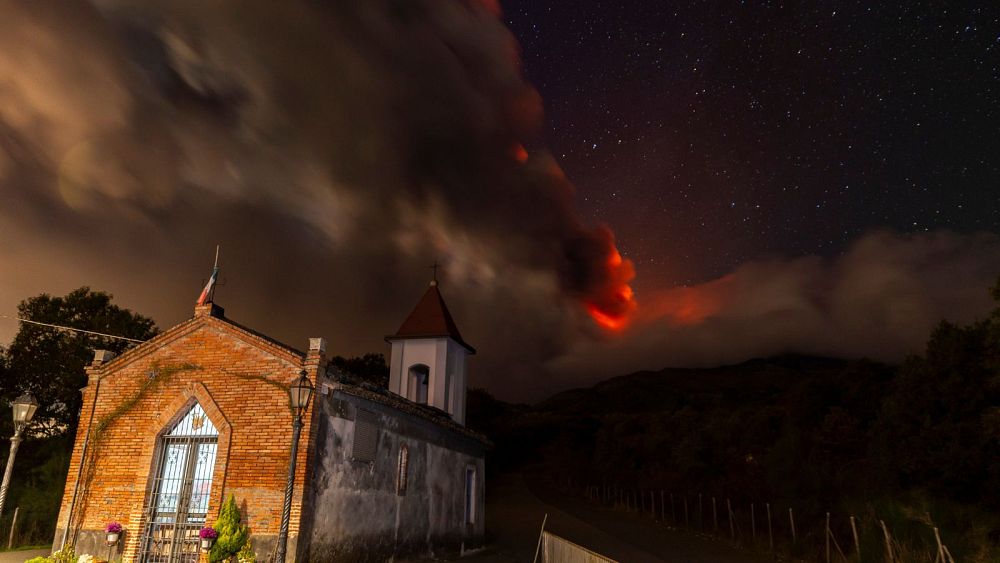Here’s what you need to know about Mount Etna, Europe’s most active volcano, and how it affects travel and tourism.
Mount Etna lit up the skies over Sicily last night (12 November) after a quiet few months.
One of the world’s most active volcanoes, Etna’s dramatic displays are rarely out of the headlines for long.
In August, Catania airport was forced to close temporarily and driving restrictions were put in place following an eruption that spewed ash over the surrounding area.
But there’s no sign that international travel to the Italian island is disrupted on this occasion, despite the awe inspiring photos of billowing smoke and bright red lava.
Meanwhile Iceland has declared a state of emergency over fears of an imminent volcano eruption, which could cancel flights.
If you’re thinking of booking a holiday to Catania and eastern Sicily, you may be concerned that volcanic activity could disrupt your trip.
Here’s everything you need to know about how often Mount Etna erupts and how it affects travel and tourism.
How often does Mount Etna erupt?
Mount Etna is one of the most active volcanoes in Europe and has been in an almost constant state of activity for the last decade.
There can be eruptions multiple times in a year and even in a month. The current eruption period began in 2013, according to the Smithsonian Global Volcanism Program.
In 2021, Etna emitted so much volcanic material over a sixth-month period that it grew in height by almost 30 metres.
This year there have already been multiple eruptions. Websites like Volcano Discovery track Etna’s activity in detail and you can watch a live stream of the volcano on the Etna Observatory site.
Most of the time, Etna’s explosions are classed as low-level volcanic activity. This includes ash plumes, lava fountaining and Strombolian explosions – mild blasts of magma which are nonetheless dramatic to observe.
Italy’s National Institute of Geophysics and Volcanology said that the height of last night’s eruptive column is estimated to be about 4500 metres above sea level.
Is Mount Etna safe to visit?
Mount Etna is considered to be a safe volcano – most eruptions do not endanger those visiting or living in the area.
Often, the biggest inconvenience is the ash that carpets surrounding towns during eruptions. This also forces Catania airport to occasionally close as occurred earlier this week and in May this year.
The volcano is under intense surveillance. The National Institute of Geophysics and Volcanology of Catania has a system of cameras, sensors, computers and human controls on site that record and communicate tremors in real-time.
However, on occasion the volcano has posed a threat. In 1928, the entire town of Mascali was wiped out. In the 1990s, surging lava threatened the town of Zafferana Etnea and had to be directed away by digging canals.
Most recently, in 2002, steams of lava destroyed shops, hotels and restaurants in the area of Piano Provenzana.
What’s more, Etna should not be underestimated by visitors hoping to climb its slopes.
Excursion company Go Etna advises visitors to always go accompanied by a local guide or agency – if you want to hike past the 2,900-metre mark it is compulsory to hire a guide.
They also recommend you notify your hotel or B&B of your route and, if skiing, that you don’t go off-piste.
Can you visit Mount Etna during an eruption?
As volcanic activity is generally at a low level, you can visit the volcano even during an eruption.
There are plenty of hiking routes that steer well clear of the summit and craters where explosions take place.
Visiting during an eruption is a thrilling experience and some guides organise tours at night especially to marvel at the fiery light show.

Sophie Anderson, a UK-based writer, is your guide to the latest trends, viral sensations, and internet phenomena. With a finger on the pulse of digital culture, she explores what’s trending across social media and pop culture, keeping readers in the know about the latest online sensations.








